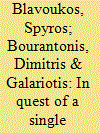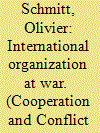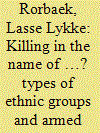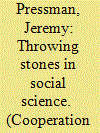|
|
|
Sort Order |
|
|
|
Items / Page
|
|
|
|
|
|
|
| Srl | Item |
| 1 |
ID:
156550


|
|
|
|
|
| Summary/Abstract |
This article looks at how Belarus, the most affected state by the Chernobyl nuclear disaster, discursively constructs cooperation with foreign countries that provide help in combating the consequences of the tragedy. It shows that different representations of foreign actors handling the prolonged consequences of the Chernobyl nuclear disaster contribute to developing new friendships (with Japan), questioning existing cooperation (with Russia), and softening old (with Germany) and current (with Europe) conflicts in Belarus. The article makes a contribution to three debates in identity literature in constructivist International Relations: (a) identity and foreign policy; (b) the ‘voice’ and agency of the ‘Rest’; and (c) identity and difference. It is argued that when small non-Western states (help receivers) construct an ethical identity of bigger Western and non-Western states (help providers), they challenge the existing temporal and spatial identities of old strangers, enemies, and friends and create a new platform for conflict and cooperation.
|
|
|
|
|
|
|
|
|
|
|
|
|
|
|
|
| 2 |
ID:
156548


|
|
|
|
|
| Summary/Abstract |
In May 2011, the United Nations General Assembly (UNGA) passed Resolution 65/276 that enhances the European Union (EU) institutional mode of representation in the UNGA and other multilateral fora operating under its auspices. This followed an earlier, failed attempt that caused much embarrassment and political turmoil in the EU. The article examines the politics of this resolution, tracing its background logic, its origins and the political interactions in the UN that eventually led to its almost consensual embracement. It accounts for the failure in the first stage of the negotiations and how the EU responded to it, adjusting its bargaining strategy accordingly. This case study contributes to the better understanding of the links between intra-EU coherence and EU effectiveness as an international actor. We posit that there is one additional dimension of EU coherence not fully captured in the relevant literature. We distinguish between genuine coherence and generated coherence. The former entails homogeneity, or at least a significant degree of a priori convergence among EU member-states. The latter refers to EU positions that have emerged after hard and protracted intra-EU negotiations. The two types differ in the degree of flexibility bestowed on the EU in international negotiations.
|
|
|
|
|
|
|
|
|
|
|
|
|
|
|
|
| 3 |
ID:
156551


|
|
|
|
|
| Summary/Abstract |
This article investigates the NATO campaign in Afghanistan through a practice-based approach. The structural distribution of power within NATO, which is obviously in favor of the US, does not automatically lead to Washington’s desired outcomes, and US delegates must competently perform a certain number of practices for their power advantage to take its full effect. The article also illustrates how looking at practices helps to explain policy decisions, such as NATO’s decision to engage in Afghanistan, the establishment of an International Security and Assistance Force (ISAF) strategy and the wording of policy papers. By studying a case of military diplomacy, the article contributes to the emerging scholarship aimed at bridging the gap between diplomatic studies and practice-based approaches to International Relations.
|
|
|
|
|
|
|
|
|
|
|
|
|
|
|
|
| 4 |
ID:
156553


|
|
|
|
|
| Summary/Abstract |
This paper asks whether certain types of ethnic groups are particularly likely to take part in armed conflict. Several theoretical arguments indicate that this should be the case, often highlighting religious and racial boundaries as being more conflict-prone than, for instance, linguistic boundaries. However, the potential effects of groups being mobilized around these different boundary markers remain largely untested. The paper helps to fill this gap by analyzing conflict propensity across types of ethnic groups in a global sample for the period 1946–2009. At odds with common perceptions, the results show that the probability of armed conflict onset is not affected by whether ethnic groups are mobilized around religious, linguistic, racial, or regional markers. The effect of political discrimination on armed conflict is also not conditioned by these different boundary markers. The paper thus lends support to an inclusive conception of ethnicity and suggests that we need to focus on the social and political context rather than the specific cultural content of ethnic boundaries if we want to identify the conflicts that are most likely to escalate and turn violent.
|
|
|
|
|
|
|
|
|
|
|
|
|
|
|
|
| 5 |
ID:
156554


|
|
|
|
|
| Summary/Abstract |
The European Union (EU) is the world’s biggest donor of aid to developing countries. The provision of EU aid is conditional on respect for human rights and democratic principles in the recipient countries. This article questions to what extent norms always yield to interests in decisions over whether to sanction breaches of human rights and democracy. Building on a theory that allows the simultaneous consideration of different norms, the article suggests that rather than interests being the determining factor when the EU takes decisions on implementing sanctions, the weighing of various norms and the choice to follow one of them can explain why sanctions have been avoided in certain cases in Rwanda. The article shows that this weighing of different norms plays an important role in foreign policy decisions and can have concrete consequences with regard to sanctions. In so doing, it advances the literature on the EU’s global role by developing a theoretical account of the evaluation process and the ultimate decision to act in accordance with one norm in particular.
|
|
|
|
|
|
|
|
|
|
|
|
|
|
|
|
| 6 |
ID:
156549


|
|
|
|
|
| Summary/Abstract |
Under which conditions are principals able to regain control when agency slack has occured? While existing research highlights a number of important factors related to the conditions under which agents engage in slack, scholars have to a less extent investigated which causal mechanisms affect the ability of states to regain control of their errant agents. Extending the principal–agent literature, this contribution argues that the ability of principals to regain control of their agents depends on three causal mechanisms: the type of monitoring mechanisms; the extent of fragmentation within an international organization; and the credibility of sanctions available to member states. To illustrate this argument, I compare two cases of agency slack: at the European Commission during the Eurozone crisis in 2015; and at the World Health Organization in the 1990s. The findings suggest that regaining control of runaway agents after slack has occurred is easier when there is a low level of fragmentation within an organization and states have centralized monitoring mechanisms and credible sanction mechanisms, such as budgetary contractions, at their disposal.
|
|
|
|
|
|
|
|
|
|
|
|
|
|
|
|
| 7 |
ID:
156552


|
|
|
|
|
| Summary/Abstract |
Social scientists treat stone-throwing as a non-violent act or argue that protest movements may be primarily non-violent despite stone-throwing. However, this study of an iconic example, the first intifada (Palestinian uprising, 1987–1993), demonstrates that stone-throwing is better characterized as unarmed violence. Definitions of violence underscore that throwing rocks is a violent act. Moreover, informed observers and data collected on stone-induced injuries during four years of the intifada illustrate the bodily harm caused by stones. The throwing of stones was central to the intifada and its identity and definition. Stone-throwing was the most visible tactic Palestinians used in the first intifada. Lastly, most scholars emphasize the protestors’ perceptions when it might be that the targets’ perceptions matter more for understanding definitions of (non-)violence and subsequent policy changes. These findings challenge important social science work and the mainstream Israeli and Palestinian narratives about the first intifada.
|
|
|
|
|
|
|
|
|
|
|
|
|
|
|
|
|
|
|
|
|